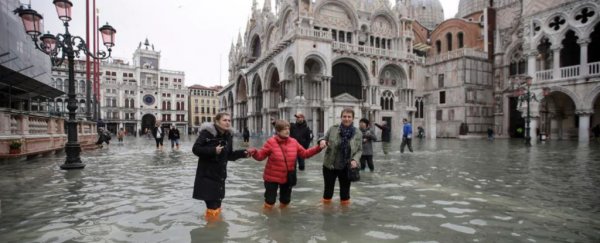More tidewater roared into Venice on Friday, layering more catastrophic floods into the lagoon city and panicking residents over the viability of living on the lip of the Adriatic Sea.
Mayor Luigi Brugnaro said the "dramatic situation" was brought on by climate change, in an appeal for additional donations to repair the devastation caused by the worst flooding in half a century.
While the city may recover on the surface, as it has before, climate scientists have said Venice is a harbinger of the problems facing all coastal cities, as melting ice sheets and warming oceans raise sea levels to unprecedented heights.
"Venice is the pride of all of Italy," Brugnaro said in a statement, the Associated Press reported, as officials said the city was 70 percent submerged. "Venice is everyone's heritage, unique in the world."
St. Mark's Square, the city's famous piazza, was closed as seagulls swarmed the knee-high water. The flood rose to over six feet in some areas. Italy declared a state of emergency and released 20 million euros to repair the extensive damage.
The total damage could run into the hundreds of millions, Brugnaro said.
Because of rising seas, extreme flooding that used to occur in Venice once every 100 years is expected to recur every six years by 2050, according to a recent report by the Intergovernmental Panel on Climate Change.
This could become far more common by 2100, recurring every five months. This only takes sea-level rise into account, which will become a progressively greater concern as time goes on.
The bigger issue: Venice is sinking. That means these flood recurrence periods, calculated for the IPCC report, are on the conservative side.
Friday's floods are due to another storm in a similar position southwest of Italy, with winds blowing from the southeast to northwest across the Adriatic, piling water toward Venice. Coming atop astronomical high tides and long-term subsidence plus sea-level rise, it's becoming easier to flood the city to severely damaging levels.
All around the busiest parts of the city, water slicked the floors of cafes and Murano glass shops and seeped into hotel lobbies, leaving a smell of sewage in its wake.
Venice, over the centuries, has diverted rivers to protect the lagoon and extended the barrier islands. But now, the sea level is rising several millimeters a year.
Offshore, at the inlets between those barrier islands, a massive project known as MOSE could potentially boost Venice's protection — with floodgates that could be raised from the sea during high tide, sealing off the lagoon.
The project, launched in 2003, was once forecast to finish in 2011. Then 2014. Now, projections call for completion in 2022.
Venice has thrived since the fifth century. But even locals with canal water in their blood are taken aback at the flooding and predictions to come.
"It's a city full of history," said Vladimiro Cavagnis, a fourth-generation Venetian gondolier who chauffeurs tourists on the city's trademark boats.
"A history that, little by little, with water, will end up like Atlantis. People are destroyed, anguished, sad. They see a city that is disappearing."
Chico Harlan and Stefano Pitrelli in Venice contributed to this report.
2019 © The Washington Post
This article was originally published by The Washington Post.
